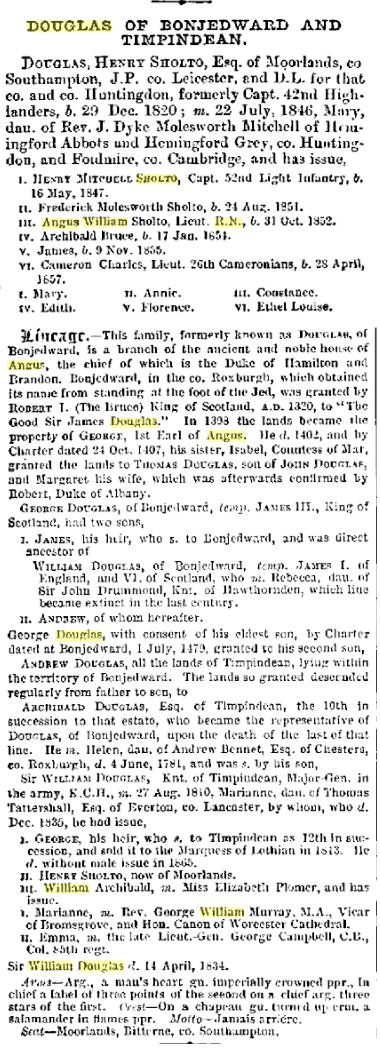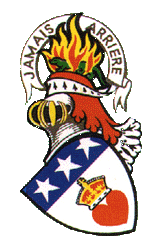Douglas
of Bonjedward, descended from a natural daughter of The First Earl of
Douglas, bore the plain Arms of Douglas with a red label of three points:
Scottish heraldry Made Easy, 1912
Arms of Douglas of Bonjedward:
Argent, a man’s heart Gules imperially crowned Proper and on a chief Azure
three mullets Argent and at the collar point a label of three points Gules
(as described in 1722).
 I
am indebted to Sally Douglas who has compiled a history of the Douglases
of Bonjedward.
This can be downloaded as a pdf. (Updated 27th March 2019) I
am indebted to Sally Douglas who has compiled a history of the Douglases
of Bonjedward.
This can be downloaded as a pdf. (Updated 27th March 2019)
This document contains detailed research, and gives reasons why our
lineage differs from other sources.
Heraldry of the Douglases by Harvey Johnston lists the Bonjedward Lairds
as –
1 Margaret Douglas and Thomas Johnson
2 John of Bonjedward
3 George
4 George
5 William (split to Andrew of
Timpendean)
6 George
7 William
8 George
9 George
10 William
11 George
12 John
We list them as –
1 Margaret Douglas and Thomas Johnson
2 John
3 George
4 George
5 William (split to Andrew of Timpendean)
6 George
7 Willie (William)
8 George
9 William *additional to above
10 George
11 George *additional to above
12 William
13 George
14 John
Two variations on the possible line:
1st Margaret c1376. Margaret and her spouse Thomas Johnson/Johnston took
the name of Douglas to inherit the unentailed lands of Bonjedward.
(Charter of 1404).
2nd John c1392. The subject of a Retour in 1439 (meant that he had
died). He died in June, 1438.
3rd George c1419. The subject of a Retour in 1452 (meant that he had
died). He died about 1452.
4th George c1441. George was one of the witnesses to a Notarial
Instrument in the monastery of Dryburgh in June 1468. He was a witness
in 1503/1504. George was the Sheriff of Roxburgh in 1509.
There was a conviction in the year 1502 (^ see below) relating to
brothers of George Douglas 4th of Bonjedward - “John Douglas, brother to
the Laird of Bon-Jedworthe, William his brother, James Douglas in
Swynside, John, Adam, and John? his brothers there,' James Douglas in
Onstoune, George Douglas in Swynside," John Davidsone in Bank, William
and George, sons of the said John, Cristopher Davidsone, John Riddale,
junior, of that Ilk, James Davidsone, son of Richard, convicted of art
and part of Oppressioun and Convocation of the lieges, and coming upon
Sir William Colvile of Uchiltre, knight', at his lands of Hardane-hede”.
(Ancient Criminal Trials by Robert Pitcairn – Vol 1, Edinburgh –
Jedworthe 1502)
[Also Jedworthe 1502 – “…Adam Douglas, and Robert, Henry, Symone and
George D, in Swynside, his brothers]
(^ See above) - Douglas Scott author of ‘A Hawick Word Book’ has
suggested that there is room for another George Douglas – Laird of
Bonjedward here as it is unlikely that men in their 60’s (or 50’s) would
have attacked Sir William Colvile. My response is along the lines - “Or
that they were convicted in 1502 but it may have happened before 1502
and I have William c1445 and John c1450 – so they would be in their 50’s
– and if born later than my estimated dates then even in their 40’s”.
The same arguments could be made for the slaughter of Thomas Rutherfurd
in Jedburgh Abbey in about 1504, except the difference is that George
Douglas the Laird of Bonjedward was accompanied by his brother John and
also it appears by a younger generation – his son Andrew Douglas the
Laird of Timpendean and another son Robert.
There is also this - George was involved in the
Skirmish at Sclaterford in 1513. The skirmish was with a large army from England. George Douglas
was one of the leaders for the Scots army. Sclaterford Bridge was
somewhere near Jedburgh. George Douglas was the Sheriff of Roxburgh in
1514. Once again is this the correct George Douglas in view of his age?
5th William c1467. He inherited Bonjedward. It was to go to his brother
James who must have died. (Andrew was to inherit Timpendean with the
agreement of James). William was mentioned in the Great Seal Register in
1540/1542. William was the Sheriff of Roxburgh in 1545. In part it was a
Commission by Queen Mary.
6th George c1488. He was at a Retour of Inquest in 1523 on the death of
John Hume at Flodden in 1513. In 1529 he was a witness to a Bond of
Alliance.
7th Willie c1513. In about 1541 Willie contributed to the reparation of
Jedburgh Abbey (such as it was). The Abbot and the Abbey responded by
giving him feu-farms in land in Toftylaws and Padohugh in Ulston. It was
said that he already had this land for 19 years. (Presumably meaning
that he had already farmed the land, with perhaps paying tenure to the
Abbey). Willie is mentioned in 1566. Willie was Deputy Warden of the
Middle Marches in 1576. James Douglas, the Earl of Morton and Regent, in
the late 1570's to the period 1578 split the Middle March into two
Wardens making William Douglas the 'bewest the strete' (Dere Sreet)
Western Warden. Morton wanted to contain the power of the encumbent
Warden William Ker of Cessford. Probably it this William who
had a brother, Hugh, described as a cousin of
John Douglas, Rector of the
University of St Andrews.
8th George c1540 was the subject of a Contact of Marriage in 1566. This
George Douglas was in the Battle of Carter Bar in July 1575. It was also
called the Raid of Reidswire.
George participated in the Middle Marches in 1584/1585 with Sir Thomas
Kerr of Fernihurst.
9th William c1570. In 1626 William had lands at Toftilaw, Padopuill and
Spittlestains. The first two were also referred to as Toftilands and
Paddapoole.
10th George c1606. In 1632 he made a discharge of 20,000 merks to Sir
Patrick Murray of Elinbank. In 1632 his sister Mary Douglas married John
Douglas 6th of Timpendean. George Douglas was a Commissioner of Public
Affairs for the Kirk in 1643. The Scottish Kirk, it appears was the
religious body trying to bring Protestantism to Scotland. The Rev James
Douglas who took his degree MA from the University of Edinburgh in 1645
was a son of Douglas of Bonjedward. He had two sons - William of
Plewlands and Newhall in 1681 and Robert.
11th George c1632. Inherited the Bonjedward title in 1682. He was sent
to prison at the time of 'the Sufferings' in 1683 and again in 1685. In
1658 the Douglases had Tutors. George Douglas was fined 6,000 l. Scots
in 1680. Was l. the Scots pound?
12th William c1652. He was mentioned in 1704.
13th George c1671. Children - John c1697 and possibly Christian in
c1701. In 1739 George granted a heritable bond over his lands of
Bonjedward to Lord Cranston. Infeftment followed. Soon after Lord
Cranston and George Douglas granted a heritable bond to James Bogle.
Lord Cassilis was somehow involved too. There are indications that he
may have been one and the same person as James Bogle? But the Earls of
Cassilis were Kennedys. Perhaps James Bogle was indebted to Lord
Cassilis? These transactions under the Court of Sessions were for monies
owing. The transactions seem to have been complicated. Once the farm
goes that is it!
14th John c1697. Retoured to both his grandfather William and his father
George in 1754. He may have had a son Andrew who was a factor on the
Lothian Estates of Bonjedward in 1733.
This Douglas line seems to have petered out sometime in the early to mid
1700’s. Some of the lands being sold off as early as the late 1600's.
Perhaps the Douglas line of Bonjedward finished as there was no
substantial property left, rather than there being a lack of a male
heir?
| Margaret Douglas |
1st of Bonjedward |
Married Thomas Johnson |
Received charter from her half sister
They took
the name: Douglas |
| John Douglas |
2nd |
|
Mentioned in above charter |
| George Douglas |
3rd |
|
Also had a son, William
retoured to his father 2
July 1439 |
| George Douglas |
4th |
|
His eldest son, James , agreed that his brother
Andrew could inherit Timpendean |
| William Douglas |
5th |
|
Presumably James died before his father, so William
inherited |
| George Douglas |
6th |
It may be this George who married Isabel Kerr |
Or Christian Murray? |
| William Douglas |
7th |
Married Rebecca Drummond |
The 'Fiar of Bonjedward'
Had a 2nd son, Rev John, minister of Yetholm and
Crailing, and a daughter Mary, who married John Douglas
of Timpendean. |
| George Douglas |
8th |
|
Mentioned 1633, dead by June 1682 |
| George Douglas |
9th |
|
Inherited 1682 |
| William Douglas |
9th |
|
Probably son of George |
| George Douglas |
10th |
|
Had a 2nd son, Rev Walter, minister of Linton, died 1727 |
| John Douglas |
11th |
|
Retoured to his grandfather 5 Jan 1754 |
| |
|
|
The next claimant is
Sir William, 11th of Timpendean. |
 Lady Isabel Douglas , daughter of
Sir Charles and Lady Douglas of Bonjedward, ran away to America in about
1742 - but she might have been the daughter of Sir Archibald Douglas, of
Bothwell Castle. Lady Isabel Douglas , daughter of
Sir Charles and Lady Douglas of Bonjedward, ran away to America in about
1742 - but she might have been the daughter of Sir Archibald Douglas, of
Bothwell Castle.
George Douglas of Bonjedward was involved in the
Raid on the Redeswire in 1575.
Rev. Walter Douglas (1674–1727) son of William of Bonjedward (probably the 12th), and brother to
the laird of Bonjedward. He was minister of Linton from 1698 to 1727. He
lived most of his life in the parish of Jedburgh, licensed by the
Presbytry of Middlebie, called 20th July, and ordained 15th September.
He was a member of the General Assembly in 1724. He was described as a
'moderate man', ie, not an evangelical minister.
Rev. John Douglas, brother of George of Bonjedward was ordained 1661 and
died 1674
Rev. James Douglas, son of William of Bonjedward ordained 1652 died 1665

 In
this depiction of the Battle of Bauge
in 1421, (click to enlarge) the pennants of
Douglas of Bonjedward are prominent. I have not yet seen evidence
that the family were present in France during these wars. In
this depiction of the Battle of Bauge
in 1421, (click to enlarge) the pennants of
Douglas of Bonjedward are prominent. I have not yet seen evidence
that the family were present in France during these wars.
 Extract
from The Rutland Papers Extract
from The Rutland Papers
Referring to William, 7th Laird of Bonjedward
Notes:
1. Presumably not the same Plewlands as mentioned as a
land holding, probably in Moray,
of Bishop Alexander Douglas.
See also:
a. Bonjedward
-
the lands
b.
Map of the area, 1654
c. Cunzeirton -
the property of William Douglas of Bonjedward, in 1540, when it
was razed and the cattle stolen.
d. Dreghorn - the
property of Hugh Douglas, in 1517
Any contributions will be
gratefully accepted |
|


